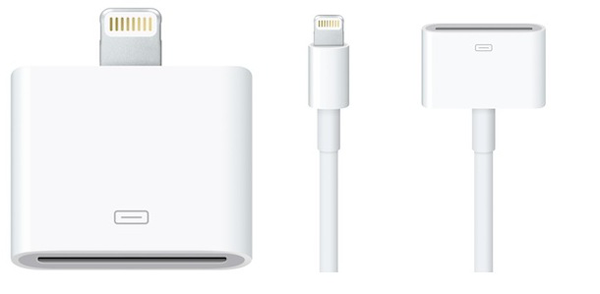Apple iPhone 5 Review: CPU, GPU, Battery, Wi-Fi, And Display Testing
The Lightning Connector
Apple also made a significant change to the connector used for synchronization, charging, and A/V connectivity. Gone is the 30-pin dock connector introduced back in 2003, replaced by a new Lightning connector. Naturally, this caused considerable angst amongst Apple enthusiasts with complete ecosystems of cables, cars, and clock radios sporting the older interface. At the end of the day, though, the change was necessary to support a slimmer iPhone 5.
Yes, we would have liked to see something like a Mini-B USB connector, the Lightning connector still allows Apple to handle the same functions as the 30-pin version using all-digital signaling, and still offer compatibility with older devices through adapters.
Let's say you recently bought an alarm clock with a dock that uses the 30-pin connector. Rather than tossing it, you have the option to pay an extra $29 for a Lightning-to-30-pin adapter. There are also adapters for converting the Lightning interface to HDMI and VGA, similar to the previous 30-Pin Digital AV Adapter, and they sell for $49 each.
Thirty bucks or more for an adapter seems pretty steep, but this isn't a case of blatant gouging. As mentioned, the Lightning is a nine-pin, eight-signal interface (there are eight gold contacts that carry the signal, but Apple considers the aluminum shell to be a contact as well). It's all-digital, though. The previous 30-pin interface included USB, video, and line-level audio outputs. Thus, Apple uses logic inside of its Lightning adapters to facilitate signal conversion.
If you buy a docking connector adapter, it will let you do the following:
- USB-based audio output, providing your sound system accepts digital input over USB
- Analog audio output to any device that uses a 30-pin connector to receive audio
- Synching and charging
Now, we've been plenty frustrated about the Lightning connector and what it might mean for our cars, our built-in iPhone/iPod docks, and subsystems that cannot be changed out, like steering wheel controls. Many of those concerns have been addressed through firmware updates, fortunately.
Kia and Hyundai owners had the most reason to worry, perhaps, because their audio systems use a breakout connector from the 30-pin interface to a 3.5 mm audio and USB data cable. However, car owners are reporting back that Apple's new adapters seem to allow full functionality. If you had steering wheel controls in the past, they should continue to work with the iPhone 5.
Get Tom's Hardware's best news and in-depth reviews, straight to your inbox.
Current page: The Lightning Connector
Prev Page Apple iPhone 5: Thin, Light, And Handle With Care Next Page A6 Processor Performance: The 400 FPS Camera Tells All-
g-unit1111 Why can't everyone - Apple included - agree on a standardized power adapter like mini USB?? It would make not only our lives easier but the manufacturers who make these accessories able to have one device and on cord that works with everything.Reply -
mayankleoboy1 The LCD tests puzzle me a little. Most other reviews said that the SGS3 has a poorer display and the iphone5 has a better display , with much better contrast ratio and sRGB compliance.Reply
Maybe i am reading it wrong ? -
reprotected There needs to be more explanation in the quality of the screens. We all know Galaxy SIII covers a larger colour gamut, but does it beat the iPhone 5 in terms of accuracy is one big thing we want to know based on your eyes, not numbers and graphs.Reply -
kensingtron Great article ^_^Reply
Second to last paragraph:
"For example, Samsung's Galaxy S III has been on the market for a while, and its LCD is a market leader"
LCD = AMOLED -
acku kensingtronGreat article ^_^Second to last paragraph:"For example, Samsung's Galaxy S III has been on the market for a while, and its LCD is a market leader"LCD = AMOLEDReply
My apologies. On page 6 we mentioned that S3 uses AMOLED. I'll make a correction. Thanks for the shout out. -
dragonsqrrl Excellent article as usual, very comprehensive. Hopefully this helps to dispel some of the performance myths about the iPhone that seem to circulate here on Tom's.Reply -
acku mayankleoboy1The LCD tests puzzle me a little. Most other reviews said that the SGS3 has a poorer display and the iphone5 has a better display , with much better contrast ratio and sRGB compliance.Maybe i am reading it wrong ?Reply
http://news.cnet.com/8301-13579_3-57524291-37/color-me-prettier-galaxy-s3-display-outdoes-iphone-5s/ Check that one out. :)
I'd still like to add an accuracy test at some point. I need to think about how to approach that problem. The way people normally talk about color accuracy (besides deltae and gamma) are sometimes too abstract with color terms that professionals use. I'd like to find a way to present the information in a more intuitive manner. -
ojas g-unit1111Why can't everyone - Apple included - agree on a standardized power adapter like mini USB?? It would make not only our lives easier but the manufacturers who make these accessories able to have one device and on cord that works with everything.Agreed...though don't most smartphones today use the microUSB B-type connector?Reply -
dare2blink Seems apple has not inovated for a couple of years now. I´m shocked that the most inovative and arguably the best phone of the year is not even mentioned in this article. Nokia Lumia 920 is definitely the most inovative na the most complete phone reseased so far. It has much better build quality, a better screen and camera than the iphone 5, not to mention a much more inovative OS.Reply

